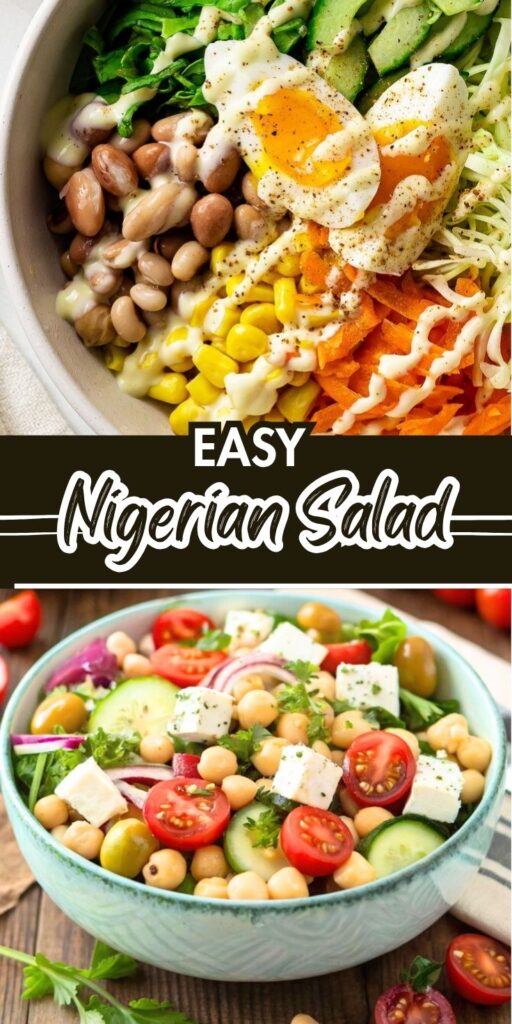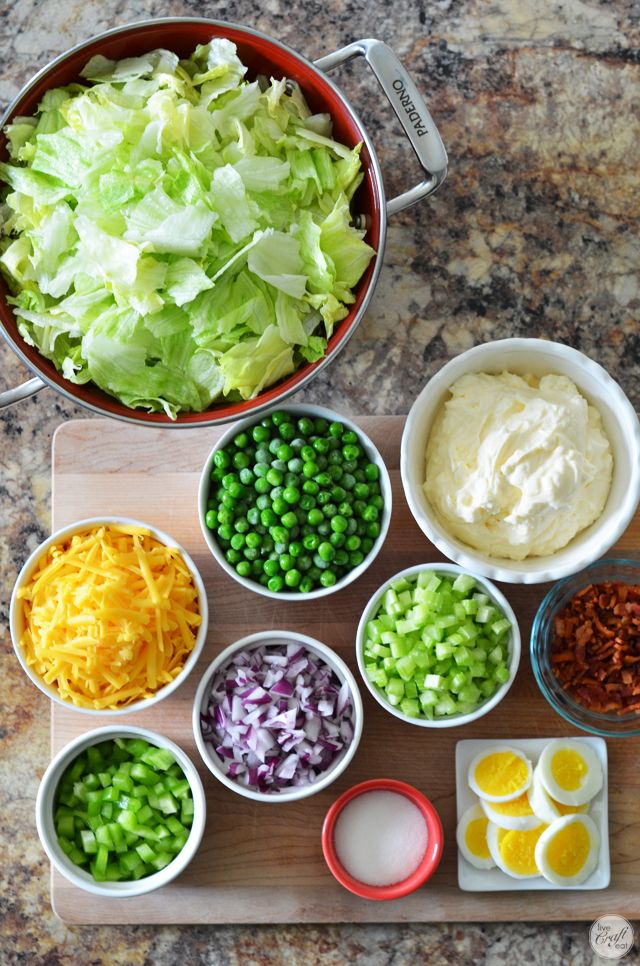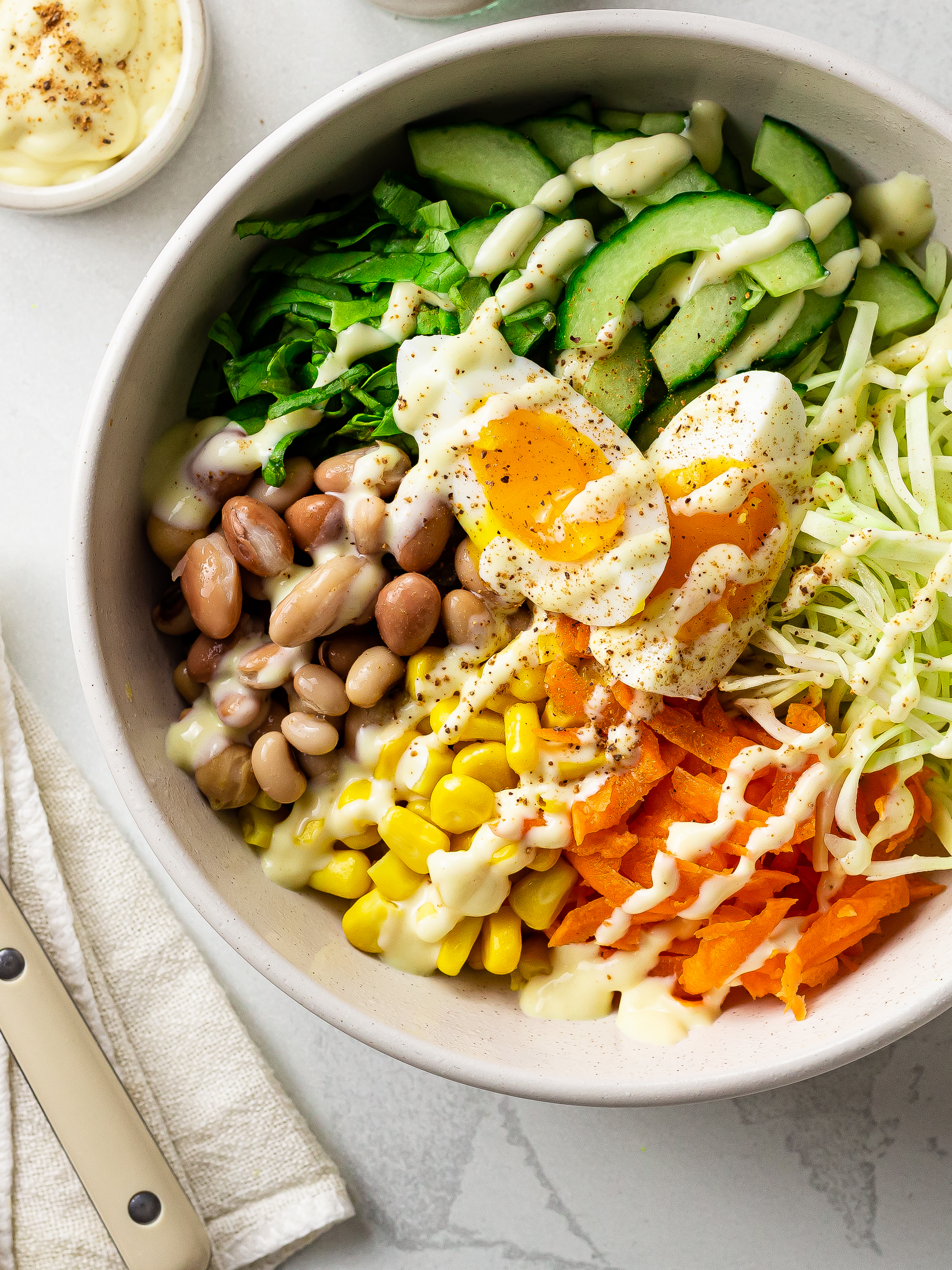
Nigerian Salad is a vibrant, hearty, and colorful layered dish that reflects the diversity and bold flavors of Nigerian cuisine. Unlike typical green salads, this version is rich, filling, and almost a meal on its own.
It features a combination of finely chopped vegetables like lettuce, cabbage, carrots, tomatoes, and cucumbers, mixed with cooked pasta, boiled eggs, baked beans, and sometimes proteins like corned beef or sardines.
This multi-textured dish is often dressed with creamy mayonnaise or salad cream, giving it a tangy, slightly sweet richness that balances the freshness of the vegetables.
Popular at parties, festive gatherings, and special family meals, Nigerian Salad is a staple on celebratory tables. It’s commonly served chilled as a side to jollof rice, fried rice, or grilled meats, adding a refreshing and creamy counterpoint to spicier dishes.
While it’s customizable based on preference or availability, the salad’s appeal lies in its vibrant look and satisfying medley of flavors and textures.
Easy to prepare ahead of time and highly nutritious, Nigerian Salad is a beloved dish that showcases how creative and flavorful African salads can be, making it a must-try for both locals and global food lovers alike.
Nigerian Salad is a vibrant, richly textured dish that goes beyond the typical idea of leafy greens. Packed with layers of crunchy vegetables, creamy mayonnaise, sweet baked beans, and sometimes proteins like eggs or corned beef, this salad is a staple side dish across Nigeria.
It’s served at parties, as a complement to rice dishes, or even as a light meal on its own. The Nigerian Salad is beloved for its bold flavors, nutritional value, and colorful presentation.
Unlike many Western salads that rely on a vinaigrette, Nigerian Salad is generously dressed with mayonnaise and occasionally sweetened condensed milk, creating a creamy and slightly tangy profile.
Its defining feature is how it combines fresh, raw vegetables with pantry ingredients like baked beans and sweet corn, balancing freshness with heartiness.
Nigerian Salad: An Amazing Ultimate Recipe
Description
Nigerian Salad is a vibrant, hearty layered salad packed with a variety of colorful vegetables, hard-boiled eggs, and sometimes proteins like corned beef or baked beans.
Unlike typical green salads, it is rich, creamy, and satisfying, often dressed with mayonnaise and served chilled.
Common ingredients include cabbage, carrots, cucumbers, tomatoes, sweet corn, peas, and onions. It’s a popular side dish at Nigerian parties, festive gatherings, and family meals.
Bursting with flavor and texture, this salad balances sweetness, crunch, and creaminess, making it a beloved staple in Nigerian cuisine.
Ingredients
Add-ins:
Dressing:
Instructions
-
Prep and cook the starchy vegetables:
Start by peeling and dicing the potatoes into small cubes. Boil them in salted water until just fork-tender (about 10 minutes). Drain and set aside to cool completely. Overcooking will result in mushy salad, so monitor closely.
While the potatoes cook, boil the eggs in a separate pot until hard-boiled (about 10–12 minutes). Cool them in ice water, peel, and slice or quarter them.
If using fresh green peas, blanch them in boiling water for about 2 minutes, then immediately transfer to cold water to preserve their bright green color and crunch. If using frozen peas, thaw and drain.
-
Prepare the raw vegetables:
-
Grate the carrots using a box grater or food processor.
-
Shred the cabbage finely with a knife or mandoline.
-
Slice the tomatoes and onions thinly. Remove tomato seeds to prevent sogginess.
-
Peel and slice the cucumber. If it has tough skin, consider peeling it in stripes.
-
Dice the bell pepper and optionally, dice an apple for added sweetness and texture.
To reduce the sharpness of raw onions, soak them in water with a little vinegar for 10 minutes, then drain.
-
-
Assemble the salad in layers:
Traditionally, Nigerian salad is layered to create a visual feast. You can use a large clear glass bowl or assemble it flat on a platter.
Layer in this order for best texture and color:
-
Cabbage (forms the base)
-
Carrots
-
Potatoes
-
Baked beans
-
Sweet corn and green peas
-
Cucumber, tomatoes, onions
-
Corned beef or diced apple
-
Repeat if needed, based on bowl depth
Top the final layer with sliced boiled eggs and a generous drizzle of mayonnaise. Add a small amount of condensed milk or sugar if you prefer a sweeter contrast, and a touch of lemon juice to balance the richness.
-
-
Chill before serving:
Nigerian Salad is best when chilled for at least 30 minutes. This allows the flavors to meld and gives the vegetables a refreshing crunch. You can serve it immediately, but it improves with a bit of resting time in the fridge.
Nutrition Facts
Servings 8
- Amount Per Serving
- Calories 350kcal
- % Daily Value *
- Total Fat 24g37%
- Cholesterol 130mg44%
- Sodium 400mg17%
- Total Carbohydrate 30g10%
- Dietary Fiber 5g20%
- Sugars 10g
- Protein 12g24%
* Percent Daily Values are based on a 2,000 calorie diet. Your daily value may be higher or lower depending on your calorie needs.
Note
Nigerian Salad is a colorful, hearty, and richly layered dish often enjoyed as a side or light main. Unlike many Western salads, this version is typically denser, featuring an array of vegetables, proteins, and even pasta or eggs. It’s a festive staple at gatherings, barbecues, and Sunday meals across Nigeria.
Below are practical tips, serving tricks, and storage guidance to help you prepare and enjoy the best version of this vibrant salad.
Tips for Making the Best Nigerian Salad
- Use Fresh Ingredients:
Nigerian salad is all about crisp textures and vibrant colors. Use fresh lettuce, juicy tomatoes, firm cucumbers, and ripe avocados. Avoid limp or soggy vegetables. - Grate or Julienne Vegetables:
Grating carrots, beets, and cabbage ensures they blend well and absorb dressing without overpowering the salad. A uniform cut improves both the texture and presentation. - Balance with Protein:
Classic additions include boiled eggs, corned beef, or canned sardines. For a vegetarian option, skip the meat and increase the egg count or add cooked beans for protein. - Sweetness from Sweet Corn and Baked Beans:
One of the salad's signature elements is sweet corn and Heinz-style baked beans. This sweet-savory combo adds body and a uniquely Nigerian taste. - Choose the Right Dressing:
Traditional Nigerian salad dressing is often simple—usually mayonnaise or mayonnaise mixed with condensed milk or salad cream. Don't over-dress. Add just enough to coat the salad. - Layer for Beauty and Flavor:
Instead of tossing everything together, layer the components in a clear glass bowl. This shows off the vibrant colors and allows guests to scoop evenly.
Serving Tricks
- Chill Before Serving:
Refrigerate the salad for at least 30–60 minutes before serving. It enhances the flavors and gives a refreshing bite. - Serve in Portions, Not Family Style (If Needed):
To keep the salad fresh at parties or events, serve it in individual cups or small bowls. This prevents over-handling and preserves the texture. - Add Dressing Last Minute:
To prevent sogginess, add the dressing just before serving. You can also let guests dress their own portions if hosting a buffet-style event. - Pairing Ideas:
Nigerian salad pairs well with jollof rice, fried rice, grilled chicken, suya, or moi moi. It's also a refreshing contrast to spicy or fried foods.
Storage Guidelines
- Refrigeration:
Store leftover salad in an airtight container in the refrigerator. If already dressed, consume within 24–36 hours to avoid sogginess. - Undressed Salad:
If you keep the dressing separate, the dry ingredients can last up to 3 days in the fridge. This is especially useful if you prep in advance. - Freezing Not Recommended:
Due to the water content in lettuce and cucumber, freezing ruins the texture. Always make fresh or keep components separate until needed.
Serving Suggestions:
Nigerian Salad is commonly served as a side dish to:
- Jollof Rice or Fried Rice
- Grilled or Fried Chicken
- Barbecue meats or Suya
- Moi Moi (steamed bean pudding)
It also stands alone beautifully as a light lunch or dinner, especially when fortified with corned beef or boiled eggs. Some people enjoy it with a slice of bread as a sandwich filling.
Storage Tips:
- Store leftovers in an airtight container in the refrigerator for up to 2 days.
- Do not freeze, as the texture of fresh vegetables and mayo will degrade.
- If making ahead, keep dressing separate and mix just before serving to retain crunch.
Customization Options:
- For a healthier version, use low-fat mayonnaise or Greek yogurt as the base dressing.
- For extra flavor, add a touch of Dijon mustard or a pinch of curry powder to the dressing.
- For vegetarians, skip the corned beef and double up on legumes like chickpeas or extra baked beans.
Conclusion
Nigerian Salad is more than just a side—it’s a celebration of textures, flavors, and colors that reflect the vibrant culture of Nigeria.
With its rich mix of vegetables, proteins, and a touch of sweetness, it stands out from conventional salads and satisfies a broad range of palates.
By using fresh ingredients, layering thoughtfully, and adding the dressing just in time, you can elevate a humble salad into a show-stopping dish.
Whether served at a festive gathering or a casual family meal, Nigerian Salad remains a beloved favorite, uniting tradition with taste on every plate. Keep it chilled, prep smart, and serve with pride!
Frequently Asked Questions
What is Nigerian Salad?
Nigerian Salad is a rich, colorful, and hearty layered vegetable salad popular in Nigeria and West Africa. Unlike lighter Western-style salads, it’s often treated as a complete meal or a side dish.
It typically includes vegetables like lettuce, cabbage, carrots, cucumbers, and tomatoes, combined with ingredients like baked beans, boiled eggs, sweet corn, and sometimes macaroni or potatoes.
It's often dressed with mayonnaise or cream-based salad dressings, making it creamy and filling.
What makes Nigerian Salad unique?
What sets Nigerian Salad apart is its abundance of layers and ingredients, often combining fresh vegetables with cooked staples.
The inclusion of items like baked beans in tomato sauce, boiled eggs, and sometimes corned beef or pasta gives it more substance. It’s not just a “side salad” – it’s hearty enough to be a meal.
Another unique feature is the liberal use of mayonnaise, giving it a creamy texture and tangy flavor, loved across Nigerian households.
When is Nigerian Salad typically served?
Nigerian Salad is commonly served at parties, weddings, and festive occasions alongside Jollof rice, fried rice, or grilled meats. It’s also enjoyed at home during Sunday lunch or as a refreshing but substantial dish on hot days. It’s best served chilled and fresh to preserve its crunch and flavor.
Can it be customized or made healthier?
Absolutely! You can reduce or swap the mayonnaise with Greek yogurt or a light vinaigrette for a healthier option.
Vegan versions omit eggs and meat. Other additions include green peas, boiled potatoes, or pineapple chunks for a sweet touch.
It’s a versatile salad that adapts easily to personal taste while keeping its vibrant, wholesome character.








